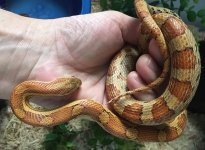SnakeSmithS
SnakeSmithS
I'm just curious if folks are interested in discussing Cinder, ...specifically, if anyone has opinions, or even better, evidence, that Cinder is in fact, incomplete dominant rather than recessive. This has been discussed in a couple places online previously, but I thought it might be interesting to see if anyone out there has anything new to add.
Personally, I have seen many heterozygous Cinder that clearly had phenotypic features that could not be explained by the presence of other gene mutations. I'm curious if others have had similar, or different experiences.
Thanks in advance for contributing to the discussion. Photos that demonstrate your points are always welcome
Personally, I have seen many heterozygous Cinder that clearly had phenotypic features that could not be explained by the presence of other gene mutations. I'm curious if others have had similar, or different experiences.
Thanks in advance for contributing to the discussion. Photos that demonstrate your points are always welcome

